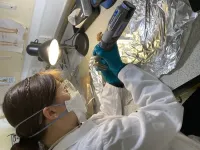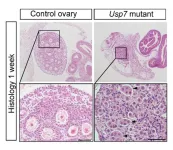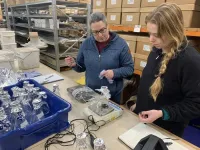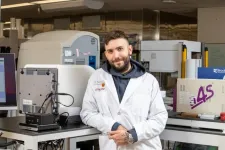(Press-News.org) PHILADELPHIA— Only a very small percentage of neurons show changes after an epileptic seizure in mice, but these alterations can be permanent and trigger future seizures that can affect the whole brain and lead to impaired cognition, like memory and learning, according to new research from the Perelman School of Medicine at the University of Pennsylvania. The researchers identified an experimental treatment that, if provided within the first 48 hours after the first seizure, can prevent these long-term changes. The findings, which were published recently in The Journal of Clinical Investigation, suggest a promising target for developing treatments for epilepsy and preventing downstream effects of seizures.
Epilepsy is characterized by excessive activity of brain cells – neurons – which generate seizures. Research is increasingly showing that the development of epilepsy involves changes of synapses, which are structures that connect one neuron to another. While an estimated 3.4 million people in the United States live with some form of epilepsy, it is still unknown what causes it, and there is no cure. Further, half of individuals with epilepsy experience cognitive impairment, such as problems with memory, or with emotional regulation, but it remains unclear why or how epilepsy changes brain cells to cause this. What’s more, epilepsy is common in children with autism and individuals with dementia.
“It is clear that there is some connection between an epileptic brain, impaired memory and trouble controlling emotions and how we act on those feelings, but we don’t understand the underlying mechanisms,” said Frances E. Jensen, MD, chair of the Department of Neurology, and senior author of the study. “Existing treatments for epilepsy only help manage seizures. This research gives us a promising starting point for developing therapies that prevent them from happening.”
In this study, the researchers used a method that “tagged” neurons in the hippocampus—an area commonly affected by epilepsy, and critical for memory—of mice that were activated by epileptic activity. The researchers were able to monitor those activated neurons over time and observe how they responded to subsequent seizures. They found that only about twenty percent of neurons in the hippocampus were activated by seizures. Over time, the overactivity of these neurons diminished their ability to make connections with other neurons, called synapses, which is necessary for learning.
“The overactive neurons lose their ability to build the strong synapses necessary for learning, which may explain why some people with epilepsy have trouble with learning and with memory,” said Jensen. “If we can stop these neurons from undergoing changes after being activated by seizures, our hope is that we can also prevent not only the progression of epilepsy, but also avoid these cognitive deficits individuals experience long-term.”
To see if they could prevent neurons from becoming permanently epileptic, the researchers used an experimental glutamate receptor-blocker, called IEM-1460, which has been shown to reduce neuron hyperexcitability in models of mice with epilepsy. They found when they treated mice with this blocker in the first 48 hours after their very first seizure the neurons did not become permanently activated, and the subjects did not experience future seizures or the associated effects, like impaired cognition and trouble learning.
“Now that we have identified the subgroup of neurons that are impacted by epilepsy, we can investigate what makes these cells vulnerable to becoming epileptic, and whether that is something we can develop a therapy to stop,” said Jensen. “We are also eager to determine whether there is a glutamate receptor-blocker that works similarly to IEM-1460 in humans, which could be given to people after their first seizure, and prevent the lifelong struggles associated with epilepsy.”
For more information about epilepsy treatment at Penn Medicine, visit: https://www.pennmedicine.org/for-patients-and-visitors/find-a-program-or-service/neurology/comprehensive-epilepsy-center.
For information on epilepsy clinical trials at Penn Medicine, visit: https://clinicalresearch.pennmedicine.org/us/en/.
This research is funded by the NIH (R37NS115439 and R01NS080565).
###
Penn Medicine is one of the world’s leading academic medical centers, dedicated to the related missions of medical education, biomedical research, excellence in patient care, and community service. The organization consists of the University of Pennsylvania Health System and Penn’s Raymond and Ruth Perelman School of Medicine, founded in 1765 as the nation’s first medical school.
The Perelman School of Medicine is consistently among the nation's top recipients of funding from the National Institutes of Health, with $550 million awarded in the 2022 fiscal year. Home to a proud history of “firsts” in medicine, Penn Medicine teams have pioneered discoveries and innovations that have shaped modern medicine, including recent breakthroughs such as CAR T cell therapy for cancer and the mRNA technology used in COVID-19 vaccines.
The University of Pennsylvania Health System’s patient care facilities stretch from the Susquehanna River in Pennsylvania to the New Jersey shore. These include the Hospital of the University of Pennsylvania, Penn Presbyterian Medical Center, Chester County Hospital, Lancaster General Health, Penn Medicine Princeton Health, and Pennsylvania Hospital—the nation’s first hospital, founded in 1751. Additional facilities and enterprises include Good Shepherd Penn Partners, Penn Medicine at Home, Lancaster Behavioral Health Hospital, and Princeton House Behavioral Health, among others.
Penn Medicine is an $11.1 billion enterprise powered by more than 49,000 talented faculty and staff.
END
The University of Houston is proud to announce the appointment of two distinguished professionals to key leadership roles within the Office of Technology, Transfer, and Innovation (OTTI) under the Division of Energy and Innovation. These appointments mark a significant step forward in the University's continued commitment to fostering entrepreneurship, innovation and partnerships between academia and industry.
Haleh Ardebili, the Kamel Salama Endowed Professor of Mechanical Engineering, has been appointed as the new assistant vice president of Entrepreneurship and Startup Ecosystem. Michael Harold, ...
The ice-encrusted oceans of some of the moons orbiting Saturn and Jupiter are leading candidates in the search for extraterrestrial life. A new lab-based study led by the University of Washington in Seattle and the Freie Universität Berlin shows that individual ice grains ejected from these planetary bodies may contain enough material for instruments headed there in the fall to detect signs of life, if such life exists.
“For the first time we have shown that even a tiny fraction of cellular material could be identified by a mass spectrometer onboard a spacecraft,” said lead author Fabian Klenner, a UW postdoctoral researcher in Earth and space sciences. ...
Archaeological analysis of a near unique animal cemetery discovered in London nearly 30 years ago has revealed the international scale of horse trading by the elites of late medieval and Tudor England.
Using advanced archaeological science techniques, including studying chemical composition, researchers have been able to identify the likely origins of several physically elite horses and the routes they took to reach British shores during the formative years of their life.
These animals – akin to modern supercars – were sourced from a variety of locations across ...
Francis Crick Institute press release
Under strict embargo: 18:00hrs GMT Friday 22 March 2024
Peer reviewed
Experimental study
Animals
Researchers uncover protein interactions controlling fertility in female mice
Researchers at the Francis Crick Institute have shed light on the proteins controlling the development of ovaries in mice before and after birth. This could lead to a better understanding of how female infertility develops.
Following their research identifying the gene responsible for initiating the development ...
An international team of scientists have warned against relying on nature providing straightforward ‘early warning’ indicators of a climate disaster, as new mathematical modelling shows new fascinating aspects of the complexity of the dynamics of climate.
It suggests that the climate system could be more unpredictable than previously thought.
By modelling the Atlantic meridional overturning circulation, one of the main ocean current systems, the team which included mathematicians from the University of Leicester have found that the stability of ...
As part of a new multi-million-euro academic research programme at University College Dublin (UCD) funded by Met Éireann (the Irish National Meteorological Service) to support the further development of weather and climate services for Ireland using data science and Artificial Intelligence (AI), UCD is seeking to appoint a Full Professor of Data Science for Weather and Climate.
This exciting new senior academic post is a permanent position in the UCD School of Mathematics and Statistics arising from a funding award of €5 million over five years from Met Éireann, ...
Researchers have for the first time discovered evidence of microplastic contamination in archaeological soil samples.
The team discovered tiny microplastic particles in deposits located more than seven metres deep, in samples dating back to the first or early second century and excavated in the late 1980s.
Preserving archaeology in situ has been the preferred approach to managing historical sites for a generation. However, the research team say the findings could prompt a rethink, with the tiny particles potentially compromising the preserved remains.
Microplastics are small plastic particles, ranging from 1μm (one thousandth of a millimetre) ...
Researchers at the University of Toronto and Sinai Health have created a new platform to identify proteins that can be co-opted to control the stability of other proteins — a new but largely unrealized approach to the treatment of disease.
The researchers developed a method to interrogate the entire human proteome for ‘effector’ proteins, which can influence the stability of other proteins via induced proximity. The study marks the first time researchers have searched for effector proteins on this scale, and has identified many new effectors that could be used therapeutically.
“We found more than 600 new effector proteins in 14,000 ...
Attention editors: Under embargo by the journal Nature Machine Intelligence until Friday, March 22, 12 p.m. eastern
Hamilton, ON, Mar. 22, 2024 – Researchers at McMaster University and Stanford University have invented a new generative artificial intelligence model which can design billions of new antibiotic molecules that are inexpensive and easy to build in the laboratory.
The worldwide spread of drug-resistant bacteria has created an urgent need for new antibiotics, but even modern AI methods are limited ...
UNIVERSITY PARK, Pa. — Eating one avocado per day may improve overall diet quality, according to a team led by researchers in Penn State’s Department of Nutritional Sciences. Poor diet quality is a risk factor for many diseases, including heart disease, and many American adults have poor diet quality and do not meet key dietary recommendations provided by the Dietary Guidelines for Americans.
This study was led by Kristina Petersen, associate professor of nutritional sciences, and Penny ...







